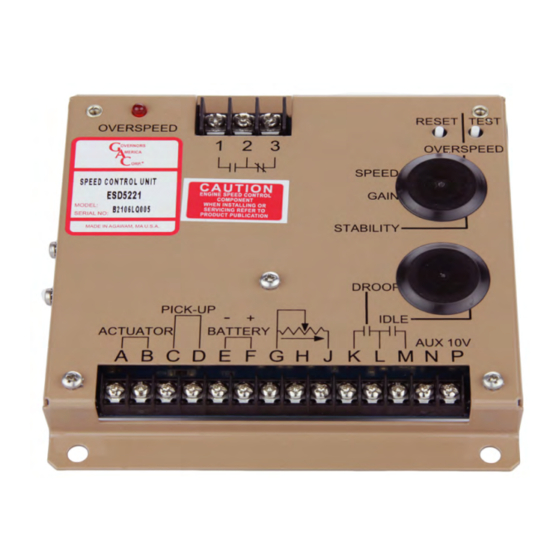GAC ESD-5550 Series Technische informatie - Pagina 11
Blader online of download pdf Technische informatie voor {categorie_naam} GAC ESD-5550 Series. GAC ESD-5550 Series 12 pagina's. Speed control unit
Ook voor GAC ESD-5550 Series: Handmatig (8 pagina's), Handmatig (8 pagina's)

Technical Information
Electromagnetic Compatibility (EMC)
EMI SUSCEPTIBILITY - The governor system can be adversely affected by large interfering signals
that are conducted through the cabling or through direct radiation into the control circuits.
All GAC speed control sensors contain filters and shielding designed to protect the unit's sensitive
circuits from moderate external interfering sources. Although it is difficult to predict levels of
interference, applications that include magnetos, solid sate ignition systems, radio transmitters,
voltage regulators or battery chargers should be considered suspect as possible interfering
sources.
If it is suspected that external fields, either those that are radiated or conducted, are or will affect
the governor systems operation, it is recommended to use shielded cable for all external
connections. Be sure that only one end of the shields, including the speed sensor shield, is
connected to a single point on the case of the speed control unit. Mount the speed control to a
grounded metal back plate or place it in a sealed metal box.
Radiation is when the interfering signal is radiated directly through space to the governing system.
To isolate the governor system electronics from this type of interference source, a metal shield or
a solid metal container is usually effective.
Conduction is when the interfering signal is conducted through the interconnecting wiring to the
governor system electronics. Shielded cables and installing filters are common remedies.
In severe high-energy interference locations such as when the governor system is directly in the
field of a powerful transmitting source, the shielding may require to be a special EMI class
shielding. For these conditions, contact for specific recommendations.
Instability
Instability in a closed loop speed control system can be categorized into two general types.
PERIODIC appears to be sinusoidal and at a regular rate. NON-PERIODIC is a random wandering or
an occasional deviation from a steady state band for no apparent reason.
Switch C1 controls the "Lead Circuit" found in the ESD-5550/5556/5570. The normal position is
"ON." Move the switch to the "OFF" position if there is fast instability in the system.
Switch C2 controls an additional circuit added in the ESD-5550/5570 that is designed to eliminate
fast erratic governor behavior, caused by very soft or worn couplings in the drive train between
the engine and generator. The normal position is "OFF." Move to the "ON" position if fast erratic
engine behavior due to a soft coupling is experienced.
The PERIODIC type can be further classified as fast or slow instability. Fast instability is a 3 Hz. or
faster irregularity of the speed and is usually a jitter. Slow periodic instability is below 3 Hz., can
be very slow, and is sometimes violent.
If fast instability occurs, this is typically the governor responding to engine firings. Raising the
engine speed increases the frequency of instability and vice versa. In this case, placing switch C1
in the "OFF" position will reduce the speed control unit's sensitivity to high frequency signals.
Readjust the GAIN and STABILITY 1or optimum control. Should instability still be present, the
removal of E1 to E2 jumper may help stabilize the engine. Post locations are illustrated in Diagram
1. Again, readjust the GAIN and STABILITY for optimum control. Interference from powerful
electrical signals can also be the cause. Turn off the battery chargers or other electrical equipment
to see if the system instability disappears.
